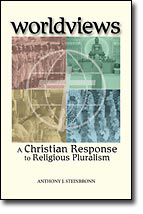 book.
I was also intrigued by the fact that the author is a district
official in the Missouri Synod. According to the back cover of
the book, the author:
book.
I was also intrigued by the fact that the author is a district
official in the Missouri Synod. According to the back cover of
the book, the author:
Reviewed by Karl Amo
I received Worldviews from the Issues, Etc. radio program as
a book-of-the-month in the summer of 2007. It was a newly-published
book from Concordia Publishing House. My interest in worldviews
and apologetics immediately drew me to the  book.
I was also intrigued by the fact that the author is a district
official in the Missouri Synod. According to the back cover of
the book, the author:
book.
I was also intrigued by the fact that the author is a district
official in the Missouri Synod. According to the back cover of
the book, the author:
Anthony J. Steinbronn serves as the Mission Executive for The Lutheran Church – Missouri Synod, New Jersey District. He is a graduate of Concordia Seminary, St. Louis (1982). He has a master’s degree in Luther Studies and a Doctor of Missiology from Concordia Seminary, Fort Wayne.
In The Gospel of John, Philip tells Nathanael about Jesus of Nazareth. Nathanael asks, “Can anything good come out of Nazareth?” Philip replies, “Come and see.” In like manner I wondered whether anything good can come out of the New Jersey District, and went to see by reading the book.
Worldviews consists of nine chapters. In the first five chapters, Steinbronn describes seven worldviews: Buddhism, Confucianism, Hinduism, Islam, tribalism, modernism, and a biblical view. The titles of the five chapters are:
Each worldview is described in each of the five chapter topics. While this approach has the advantage of repeatedly exposing the reader to each of the worldviews, it reduces the value of the book as a reference source after one has read it. For example if one wants to review a specific insight into Islam, one might need to look through five chapters to find it. I think that it would have been better to have described each worldview in its own chapter. I think that it would have also helped if the publisher had included an index.
The title of Chapter Six is “The Orders and Root Metaphors of the Modern and Postmodern Condition.” Here, Steinbronn explains that in Western society, Christianity has been sidelined to the private world of beliefs, opinions, and values; it is strictly separated from the public world of facts.
The title of Chapter Seven is “Observations and Strategies.” Here, Steinbronn provides a prescription to the problem of competing truth claims. Unfortunately, he fails to provide a compelling apologetic for Christianity. On page 186 Steinbronn states:
In general, Christian theology is recognizable by the fact that it is based on the great fundamental axiom: God has revealed Himself in the world of space and time. However, this axiom cannot be demonstrated but can only be received by faith; therefore, plain and simple unbelief is the only reason for rejecting it and throwing it aside.
The axiom requires an arbitrary decision and commitment from the non-Christian. It is essentially the same as the axiom that Muslims use for believing in Allah, the Koran, and Mohammed. In contrast, John Warwick Montgomery in his book Tractatus Logico Theologicus makes a compelling apologetic for Christianity from evidence – the historicity of Jesus and His crucifixion, and the testimony of the Gospels regarding Jesus rising from the dead and His claims about Himself. In the essay “The Apologetic Thrust of Lutheran Theology” which was published in 2007, Montgomery argues that the lack of an apologetic-based-on-objective-fact leads to a confusion of Law and Gospel.
In lieu of providing a compelling argument for the truth claims about Jesus, Steinbronn recommends that “God’s people…. uphold, affirm, confirm, and spread His truth” and that the truth-claims of Scripture be interpreted, explained, and communicated for “meaningful application within every area of human life.” Further in the chapter, in a section entitled “Reinventing the Congregation for a New Mission Frontier”, Steinbronn prescribes a new definition of a congregation’s ministry:
The local congregation’s ministry entails committing to serve and strengthen the fabric of the community and society, nurturing an intensity of faith-commitment, engaging in a lifestyle imitative of Jesus, bringing the stranger into a life-giving relationship to the Gospel and to the nurturing community, and being a faith community that stands for something (confessional) and yet is able to provide wide entry points so that the lost might be included and healed (evangelical).
Steinbronn is very wrong. Article VII of the Augsburg Confession defines the Church as “the assembly of all believers among whom the Gospel is preached in purity and the Sacraments are administered according to the Gospel.” Note that the definition says nothing about character of believers, but rather describes what happens at the assembly of believers. That is because believers are justified sinners; they are justified by grace through faith. Steinbronn though, wants congregations to work for specific characteristics among believers, such as intense commitment, imitation of Jesus, and nurture. Doing what he wants would replace the Gospel with the Law, the fruit of which would be hypocrisy and/or despair.
Considering what Steinbronn prescribed in Chapter Seven, I do not see much point in describing the last two chapters. The review is over. I do not recommend Worldviews.